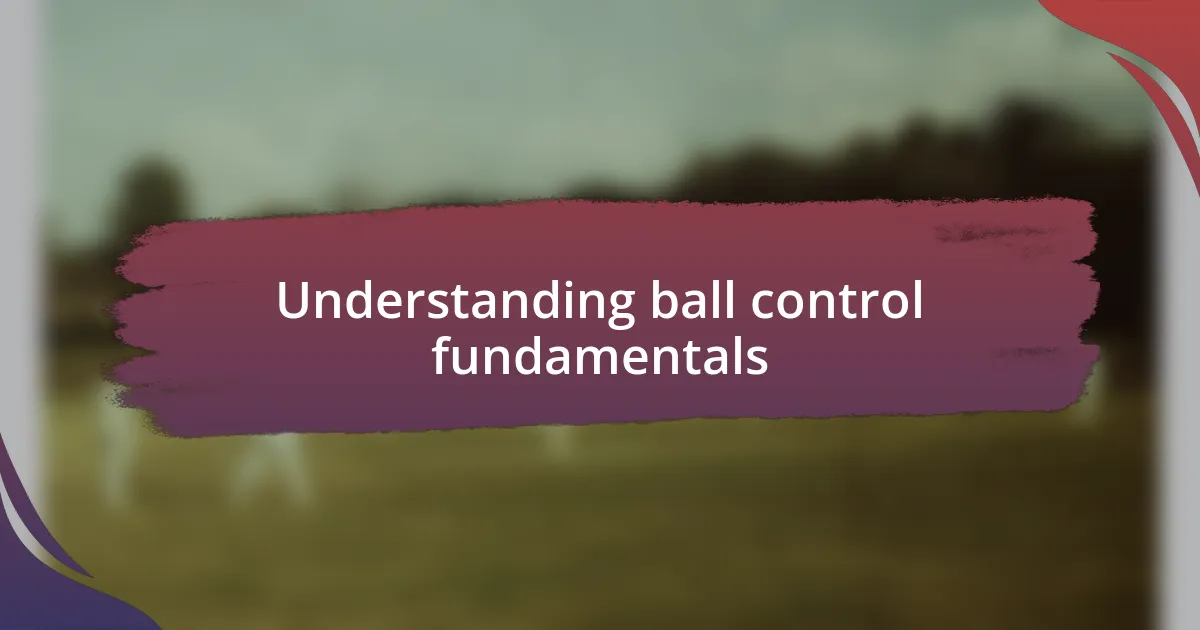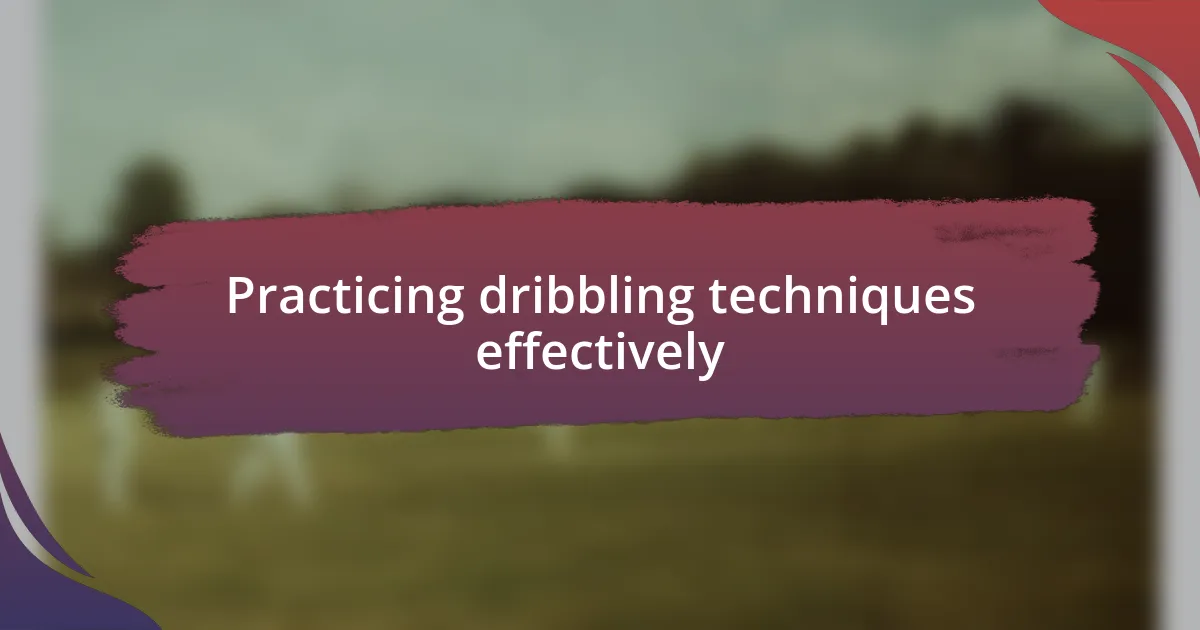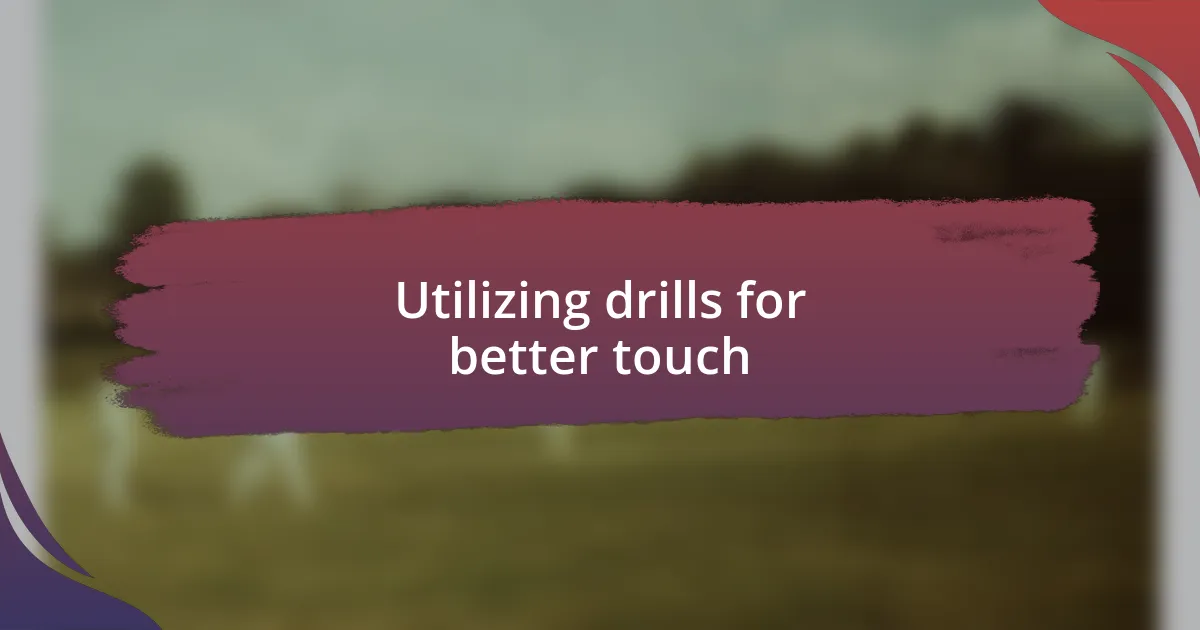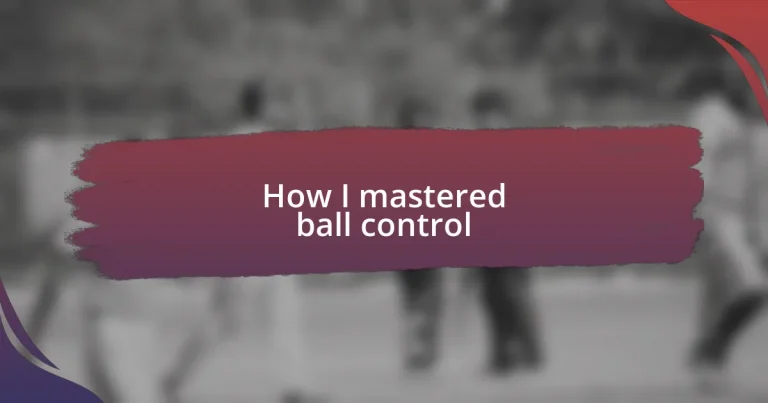Key takeaways:
- Mastering ball control requires understanding touch, body positioning, and instinctive reactions to the ball.
- Effective dribbling practice involves structured drills targeting speed, control, and adaptability with both feet.
- Incorporating small-sided games enhances ball control by simulating game pressure and unpredictability.
- Tracking progress through goal setting and self-reflection fosters improvement and motivates skill development.

Understanding ball control fundamentals
When it comes to mastering ball control, understanding the basics is key. One of the first lessons I learned was to recognize how the ball reacts to different types of touches. I remember the first time I miscalculated a gentle pass; my heart dropped as the ball rolled away. It was a humbling moment that taught me the importance of touch—not too hard, not too soft.
I’ve found that body positioning plays an essential role in ball control. Adjusting my stance based on the ball’s trajectory can make all the difference. Have you ever noticed how your balance affects your ability to trap or dribble the ball? I did during a practice session when I shifted my weight too far back, and I lost control. That taught me to always be aware of my center of gravity.
Then there’s the instinctive reaction to the ball—something I’ve come to value immensely over the years. It’s that split second when you decide whether to shield, pass, or take a quick shot. I still recall the adrenaline rush I felt during a crucial game when I intercepted a pass and made a perfect touch. Developing that instinct takes practice, but it’s akin to forming a bond with the ball; the more you nurture it, the more intuitive your responses become.

Practicing dribbling techniques effectively
Practicing dribbling techniques effectively requires a structured approach. I often dedicate time to specific drills that target different aspects of dribbling, like speed and control. One particular drill that I enjoyed was the cone weave. It not only sharpened my directional changes but also pushed my limits on how tight I could maneuver the ball. I remember the thrill of slipping the ball through the cones at high speed, feeling in complete command, which motivated me to keep refining that skill.
To make the most of your practice sessions, consider these techniques:
- Use various surfaces: Practice on different terrains like grass, concrete, or even sandy areas to adapt your control.
- Vary your speed: Alternate between slow, controlled dribbling and quick bursts to improve your adaptability.
- Incorporate both feet: Spend equal time using your dominant and non-dominant foot to prevent any weaknesses.
- Focus on visualization: Imagine game scenarios while practicing to better prepare for actual matches.
- Record your sessions: Watching my practice footage helped me identify areas for improvement that I hadn’t noticed in real-time.

Utilizing drills for better touch
Utilizing drills is essential for developing better touch on the ball. I often found that the simplest drills yielded the most remarkable results. For instance, I spent countless hours doing the “Juggle and Pass” drill. It involved juggling the ball with my feet and thighs before making precise passes against a wall. The thrill of crisp contact and the sight of the ball returning to me honed my touch and built my confidence dramatically.
A specific drill that has greatly benefited my ball control journey is the “Inside-Outside Touch”. By repeatedly tapping the ball using the inside of my foot and then the outside, I developed a more refined feel for the ball. In those moments, I could almost say I became one with the game. Feeling the ball respond to my every intent was a pivotal experience that enhanced not just my skills, but my love for the sport.
Drills like “Tic-Tac Toe” with cones can also elevate your touch significantly. In this, I positioned cones in the shape of a traditional game board and moved the ball in swift patterns to navigate through them. This exercise forced me to focus on both speed and precision, and with each attempt, I could perceive a subtle improvement in my ball control. It felt like each completed round was a small victory that kept me motivated to push the boundaries of my touch.
| Drill Name | Description |
|---|---|
| Juggle and Pass | Juggling the ball before passing it against a wall for improved touch. |
| Inside-Outside Touch | Tapping the ball with the inside and outside of the foot to refine control. |
| Tic-Tac Toe | Navigating a cone layout to enhance speed and precision of touch. |

Incorporating small-sided games
Incorporating small-sided games into my training routine was a game changer for my ball control. I remember the first time I played a 3v3 game; the tight spaces forced me to think quickly and maneuver the ball under pressure. Did I feel overwhelmed? Absolutely. But that pressure instilled a sense of urgency that sharpened my skills faster than any drill could.
What I found particularly rewarding was the unpredictability of these games. Unlike a typical drill, every match brought unique challenges. I couldn’t rely solely on technical skills; I had to read the game, anticipate movements, and adapt my touch accordingly. It was exhilarating to experience how working within tight confines taught me not just to control the ball, but to possess an almost intuitive connection with it.
At times, I would find myself in a heated exchange during a small-sided game, and I could feel the adrenaline coursing through me. The moments when I executed a perfect touch to bypass an opponent were electrifying. It made me realize that the intensity of competition could transform my understanding of ball control in extraordinary ways. Engaging in these games not only enhanced my technique but also ignited my passion for the sport all over again.

Analyzing professional players’ skills
Professional players showcase ball control in a way that often leaves me in awe. Watching them maneuver the ball with such precision makes me reflect on the countless hours they’ve dedicated to perfecting their touch. I sometimes wonder, how do they maintain that level of composure when facing intense pressure? It’s a combination of muscle memory and mental fortitude that can only be developed through relentless practice.
One of the standout aspects of their skills is their ability to anticipate not just their own movements but those of their opponents as well. I recall a match where I studied a player who effortlessly weaved through defenders. He wasn’t just reacting; he seemed to be always a step ahead, which made me realize the importance of reading the game. I often remind myself that it’s not just about technical ability; it’s about understanding the flow of the game and positioning oneself accordingly.
In my journey to mastering ball control, I have drawn inspiration from how professionals use their body and space to protect the ball. During a recent practice session, I applied their techniques, focusing on maintaining balance while dribbling in congested areas. The feeling of being able to shield the ball effectively was empowering. It’s these insights, gleaned from analyzing the pros, that have fueled my desire to progress and elevate my own skills on the field.

Tracking progress and setting goals
Tracking my progress has been crucial in my journey to mastering ball control. I started by setting small, achievable goals—like successfully dribbling through a set of cones without losing the ball. Each time I reached a milestone, such as completing five consecutive sessions without errors, it boosted my confidence and made the process feel rewarding.
I also began keeping a journal to record my sessions, noting down what I practiced and how I felt afterward. This reflection helped me identify patterns in my performance. For instance, I realized that my footwork improved significantly when I incorporated specific footwork drills into my routine. Have you ever felt a sudden shift in your skills simply by tweaking your practice approach?
Setting long-term goals was equally important. I visualized myself performing a specific skill during a game, like executing a perfect turn to evade a defender. This vision not only motivated me but also guided my training focus. As I worked on my ball control, I could almost feel the excitement of the crowd when I successfully pulled off that skill in a match. Embracing this process has transformed my mindset; each training session now feels like a step toward realizing that vision.



